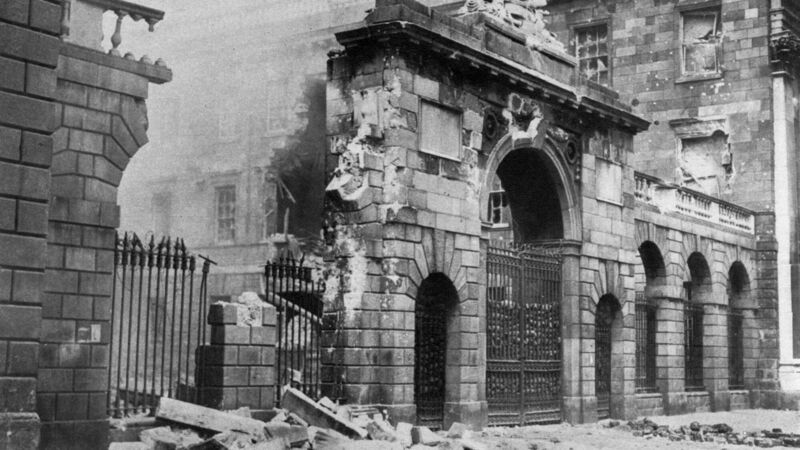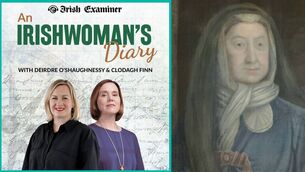Collective trauma: War inherited an awkward place in history

The Four Courts bombarded in Dublin, July 1922. Picture: The Print Collector/Print Collector/Getty Images
The centenary of the Irish Civil War belatedly throws a spotlight on the occluded history and legacy of the traumatic conflict that terminated its national revolution as it inaugurated its statehood.
As with earlier milestones in the decade of centenaries, scholarly and public energies will be devoted to recovering, revisiting, and reflecting on the events and contexts of the period.
This heavily public-facing history will be facilitated by new and more accessible archives, scholarly collaborations, and local history initiatives, with attention given to understudied topics such as women’s roles and experiences, class and sectarian questions, and international and comparative contexts.
Commemorative ceremonies are also on the official agenda, reflecting the non-partisan values of inclusive remembrance and reconciliation, but implicitly serving other present political priorities as well, as is always the case.
But more so than previous moments in the centenaries programme — with the exception of that other great unintended consequence of republican revolution: Partition and the forgotten Northern Troubles of 1920-22 — the Irish Civil War raises thorny questions about nationalist memory and history that still resist tidy resolution a century later.
HISTORY HUB
If you are interested in this article then no doubt you will enjoy exploring the various history collections and content in our history hub. Check it out HERE and happy reading

Characterised variously as the bitter intra-nationalist conflict’s long shadow, troubled ghost, historical half-life, and wounds or scars on the Irish body politic, the troubled social memory of the civil war arguably eclipses the historical event itself in both popular and scholarly discourses.
The notorious conflict’s fraught legacy is tied to both its objective and subjective significance as a watershed event, or a ‘caesura across Irish history’ in Roy Foster’s words.
Objectively speaking, the Anglo-Irish Treaty formally ended 120 years of Irish union with Britain, with roughly three quarters of Ireland leapfrogging over home rule for a greater degree of autonomy conferred by membership in the British Commonwealth.
A 26-county dominion, however, fell short of the all-island republic aspired to in 1916 and embodied in Sinn Féin’s underground government, triggering a fracture in revolutionary solidarity that proved more consequential than any previous or subsequent split in Irish nationalism’s fractious history.
So-called civil war politics and the unresolved issue of the State’s constitutional status under the Treaty monopolised southern Irish political agendas at least until de Valera’s reforms in the 1930s made the post-revolutionary state more acceptable to the bulk of anti-Treatyites.
While during debates in the revolutionary Dáil the Treaty had been advocated as ‘a damn good bargain’ given the alternatives, the bargain was ultimately struck at a very high price for Ireland.
One year of fighting between pro- and anti-Treaty factions claimed nearly as many lives as the 1919-21 War of Independence, while the Provisional Government/Free State carried out roughly three times more executions than the British had between 1916 and 1921 (mostly of young fighters but including high profile figures like Erskine Childers and Liam Mellows).
The revolution’s prisoners-turned-wardens also interned thousands more republican fighters and activists via a series of public safety measures that were renewed or strengthened in the following years.
Extra-judicial murders of surrendered fighters and captured activists at Clondalkin, Ben Bulben, Ballyseedy, the Wicklow Mountains and elsewhere rivaled the outrages of the hated Tans.

On the other side, the crushing loss of national hero Michael Collins in a roadside ambush; the untimely death of Arthur Griffith; assassination plots targeting TDs; deadly trap mines at Carrigaphooca and Knocknagoshel; and republicans’ fierce campaign of destruction took a heavy toll on the pro-Treaty camp and new state alike.
But just as significant was the subjective impact these shocking events had on the revolutionary generation.
In contrast to the nostalgically framed ‘Four Glorious Years’ of united struggle against the historic foe, participants from both sides of the Treaty split, as well as those who refused to take a side, remembered the 1922-23 ‘war of friends’ in consistently tragic, anguished terms.
It was “Ireland’s greatest tragedy,” according to Liam Deasy; a “story of failure and disruption…bitterness and antagonism” in Seán Moylan’s account.
On the other side of the divide, consular official and later Senator Joseph Connolly predicted “a heritage of bitter discord” in the civil war’s wake, while Citizen Army veteran Frank Robbins, who was neutral in the Civil War, nonetheless remembered it as “a period of unbelievable discord and tragedy.”
This collective sense of tragedy coexisted with violently polarised verdicts regarding the meaning and stakes of the revolution’s messy end.
- Did the Free State’s victory consolidate the historic gains of a respectable revolution, or was it a treacherous counter-revolution against a popularly established republic?
- Was 1922 the triumph of democracy against unaccountable militarism, or a white terror by bourgeois interests with imperialist backing?
- Did the split pit those with a ‘stake in the country’ against ‘the men of no property’, or was it a socially arid squabble over political abstractions?
- Was it even a bona fide civil war, or alternatively, an extension of the War of Independence against colonial repression by other means, or little more than a clash between state authority and lawlessness?
- Did the Treatyite victory represent the ascendancy of the most administratively talented and politically perceptive leaders of the revolutionary movement, or the ruthless liquidation of the poets, radicals, idealists, and anti-imperialists in their midst?
- Was the split inevitable or avoidable? If the latter, which side should have compromised?
- Should Ireland’s civil war ultimately be understood as an unpleasant but necessary moment in nation-state formation; the foul product of British perfidy; an unfortunate disagreement between otherwise like-minded nationalists; or the moment that fundamental incompatibilities within Irish nationalism were exposed?
The ambiguous end to the conflict in May 1923, with the Free State’s military victory undercut by republicans’ refusal to surrender their arms or recognise the state’s legitimacy, and the resumption of “business as usual” hindered by ongoing internment and political repression, failed to settle these loaded debates in the 1920s.
Or beyond, though various commentators have pointed to moments or institutions that eventually facilitated a degree of rapprochement between old enemies, whether the GAA, the church and social conservatism, or the shared experience of neutrality in the Emergency years.
There remained, however, many opportunities for the venting of old animosities, layered over with new grievances, especially during elections in the volatile 1930s when the Blueshirts and anti-Treaty IRA factions are said to have reenacted their old feud at riotous rallies.
But instead of clearly tending towards either reconciliation or retribution, the Civil War’s inherently awkward place in the national narrative of independence ultimately entailed a degree of collective forgetting, or at the very least, a shared sullen silence, as has long been the case with civil wars and other divisive historical moments in many other contexts.
Indeed, apart from the persistent influence of political and personal animosities and allegiances rooted in the Treaty split, the notion of a virtual conspiracy of silence about the “unspeakable war” (as journalist Eoin Neeson dubbed it in the late 1950s) remains the most common assumption about the period’s memory legacy.
Evidence of the conflict’s suppression in Irish social memory abound. The early Free State’s failed effort to inaugurate an annual Independence Day on the anniversary of the 1922 Constitution and the “chronicle of embarrassment” around a failed cenotaph project to honour Collins and Griffith (with the murdered Kevin O’Higgins added later) reflect the pro-Treaty establishment and new state’s uncomfortable relationship to their own origin story.

The cross-party Bureau of Military History (BMH) project also pointedly excluded the civil war period from its collection of veterans’ accounts, a temporal convention instinctively respected in most IRA memoirs and popular histories that artificially conclude at the July 1921 Truce.
Major figures such as General Mulcahy and Seán MacEoin generally refused to discuss the conflict publicly, while many other members of their generation exercised a similar circumspection within their own families.
Indeed, many children of civil war veterans have noted how little the civil war period was mentioned when they were growing up.
Yet, forgetting and silence have never been the whole story of Irish Civil War memory.
Defiant acts of remembrance, traditions of local lore, family stories and other forms of communal memory survived and were passed down despite, or because of, the taboo against public remembering at the level of the state and within establishment politics.
For example, several well-known veterans’ memoirs discuss the upsetting period in considerable detail, including Peadar O’Donnell and Dan Breen’s in the 1920s and 30s, while Deasy and Ernie O’Malley penned posthumously published volumes devoted to the Civil War.
Despite the BMH’s efforts to write it out of the revolutionary record, hundreds of witness statements nevertheless recorded impressions of the Civil War, while at the same time the BMH was created, Ernie O’Malley was traveling the country collecting fellow veterans’ revolutionary recollections, with many offering explicit accounts of civil war experiences in their locales.
Further, while the Free State’s abortive cenotaph on Leinster lawn has been likened by Anne Dolan to a rotting Napoleonic-era monument in France derisively known as ‘the elephant of revolutionary forgetfulness’, the Irish republican movement’s well-developed tradition of civil war remembrance, most dramatically represented by the massive memorial at Ballyseedy, might be called the elephant in the room that showcases the movement’s elephantine memory.
Scores of republican memorials within and without republican plots at local cemeteries honour the deaths and sacrifices of republicans in the civil war, while pointedly ignoring the experience of their estranged comrades.

Pro-Treaty commemorationism is a much rarer phenomenon — the Collins’ memorial tradition at Béal na Bláth being the exception that proves the rule — with a recent memorial to the Free State dead at Knocknagosel in North Kerry repeatedly vandalised.
The anti-Treaty movement’s stubborn counter-memory of the conflict however falls far short of a national memory reconciling old differences, and is internally riven by partisan competition between Sinn Féin and Fianna Fáil over rival claims to continuity with the civil war tradition, as can be seen by separate memorials at Clashmealcon caves.
Given this fraught legacy of remembering and forgetting, partisan enmity and collective trauma, the Irish Civil War and its memory will not be easily molded to fit official centenary agendas, even with the auspicious coincidence of the first-ever Fianna Fáil-Fine Gael coalition government presiding.
Considering the State’s heavy-handed role in the conflict itself, and the Irish establishment’s general lack of appetite for civil war commemorations in the ensuing decades, the case could be made for continued circumspection at the center in deference to local communities and traditions on the geographic and political periphery that have long kept the conflict’s memory alive.
and Social Science from the American Conference for Irish Studies.














